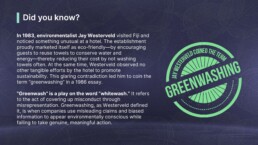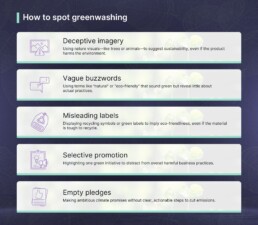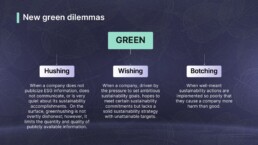Imagine a world where every product you buy promises to save the planet—cleaner oceans, greener forests, and brighter futures. Sounds perfect, doesn’t it? But what if these promises were just clever disguises, hiding practices that do more harm than good? Welcome to the shadowy realm of greenwashing, where words like “eco-friendly” and “sustainable” often mask false solutions to the climate crisis. In this Essentials Guide, we’ll peel back the layers of marketing spin, arm you with the tools to decode green claims, and help you make informed choices that truly benefit the planet. Read on to equip yourself to uncover the truth behind the green veil.
What is greenwashing?
It is the act of making false or misleading statements about the environmental benefits of a product or practice. It can be a way for companies to continue or expand their polluting as well as related harmful behaviors, all while gaming the system or profiting off well-intentioned, sustainably-minded consumers.
Why is it bad?
Greenwashing is neither good for consumers nor businesses. In a world where time is of the essence in order to tackle climate change, greenwashing is more than just misleading—it’s dangerously counterproductive. At its core, greenwashing undermines trust, deceiving consumers into believing they are supporting eco-friendly products or practices when, in reality, they are not. This misrepresentation not only exploits the good intentions of eco-conscious individuals but also diverts their support away from businesses making genuine efforts to address environmental issues.
The harm of greenwashing extends beyond consumer deception—it creates a significant barrier to progress in combating the climate crisis. When companies prioritize appearances over meaningful action, they delay critical changes needed to reduce carbon emissions, preserve natural resources, and support sustainable development. This ultimately slows down innovation and investment in truly green solutions.
Watch out!
These are the common tactics used in greenwashing:
– Making vague or ambiguous claims about environmental or social benefits.
– Misleading labels
– Using terms like “natural,” “eco-friendly,” or “green” without clear definitions or certifications
– Using green colors in packaging to give the impression of sustainability.
– Using images or symbols, like trees or people holding hands, to suggest environmental or social responsibility.
– Employing scientific-sounding terms that are not well-understood by the general public, such as “carbon footprint” or “sustainability.”
– Making claims that are technically true but are misleading or incomplete.
– Highlighting a small, environmentally or socially responsible aspect of a product or service while ignoring other aspects that are not.
A look at corporate missteps
Chevron’s “People Do” campaign:
In the mid-1980s, Chevron’s “People Do” advertising campaign used ads to highlight how they restore nature after exploiting it for oil. However, this claim was misleading since the law already required doing so. Around the same time, Chevron was in the middle of environment-related legal battles. For example, they paid $1.5 million in penalties for illegally dumping pollutants in Santa Monica Bay.
DuPont’s Ode to Joy ad:
In 1991, chemical company DuPont announced the launch of its double-hulled oil tankers with ads featuring marine animals prancing in chorus to Beethoven’s Ode to Joy. It turned out that the company was the largest corporate polluter in the US that year.
Shell’s misleading clean energy ads:
Oil and gas giant Shell faced backlash for its advertisements depicting wind turbines and solar panels despite its significant fossil fuel investments. The imagery created a misleading impression of Shell’s overall environmental impact.
Volkswagen cheats emissions tests:
In 2015, Volkswagen was found to have cheated emission tests by making its diesel cars appear far less polluting than they are. The car manufacturer admitted to installing ‘defeat devices’ in a variety of vehicles. Meanwhile, the company promoted environmentally friendly and low-emission features of its cars, like inserting a nitrogen oxide trap in the engine and a strengthened particulate filter, in its marketing campaigns. In reality, the US Environmental Protection Agency discovered that 482,000 VW diesel car engines were emitting nitrogen oxide pollutants up to 40 times above the US limit. Volkswagen later admitted that the issue affected about 11 million cars worldwide.
Nestlé’s bottled water claims:
Nestlé marketed its bottled water as sustainably sourced and environmentally friendly. However, lawsuits revealed that the company was extracting groundwater from drought-stricken areas without sufficient regulation and transparency, contradicting its claims.
In recent years, the cost of misleading sustainability claims has become significantly more tangible. For instance, Deutsche Bank’s asset management arm, DWS, settled with the United States Securities and Exchange Commission (SEC) for a hefty US$19 million in September 2023, following charges of greenwashing.
Legal measures
The European Union is at the forefront of combating greenwashing through a series of comprehensive regulations. In January 2024, the European Parliament formally approved a new greenwashing directive, requiring member states to introduce stricter rules surrounding the use of environmental claims by companies. To achieve that, the EU will ban: generic environmental claims on products without proof; claims that a product has a neutral, reduced, or positive impact on the environment because the producer is offsetting emissions; and sustainability labels that are not based on approved certification schemes or established by public authorities. EU also has the following regulations in place.
- Sustainable Finance Disclosure Regulation (SFDR): Introduces rigorous disclosure requirements that compel asset managers to report ESG metrics at both the entity and product levels.
- EU Taxonomy: Provides a clear framework to define environmentally sustainable economic activities by outlining six environmental objectives that activity must contribute to, including climate change mitigation, pollution prevention, and biodiversity protection
- Corporate Sustainability Reporting Directive (CSRD): Aims to strengthen reporting and disclosure requirements for climate and environmental performance; applies to about 50,000 companies across the EU
- Sustainability Disclosure Requirements (SDR): Tackles greenwashing by requiring all sustainability-related claims to be “clear, fair, and not misleading;” was introduced by the UK’s Financial Conduct Authority (FCA).
Regulations in Asia-Pacific
- Singapore was one of the first countries in the region to introduce a Green Labelling Scheme (GLS) to provide greenwashing regulations, requiring companies to comply with strict eco-labelling criteria to obtain a green label.
- In 2020, South Korea introduced ESG reporting and disclosure rules to support greenwashing regulations.
- China’s new Environmental Protection Tax Law imposes taxes on companies for polluting the environment, incentivizing them to reduce their environmental impact.
- Japan’s Ministry of Environment has launched a Green Claims Guidelines initiative.
- In India, the Central Consumer Protection Authority has drafted guidelines for Prevention and Regulation of Greenwashing, 2024. Several existing laws and regulatory guidelines implicitly address misleading marketing practices that exploit environmental claims.
What YOU can do to fight greenwashing
- Read product labels and advertisements carefully to spot vague language, exaggerated benefits, or incomplete claims.
- Look beyond buzzwords like “green,” “eco-friendly,” or “sustainable.”
- Investigate the company’s sustainability claims by checking for certifications, environmental reports, or third-party audits that validate their efforts.
- Read the fine print. For example, a product labeled “made from recycled materials” should specify the percentage and source of the materials.
- Seek transparency: Ask companies direct questions about their supply chain, production processes, and sustainability efforts.
- Support ethical brands: Choose companies that prioritize sustainability, transparency, and social responsibility.
- Spread awareness: Share information about greenwashing with your network. Empowering others to make informed choices and hold companies accountable.








